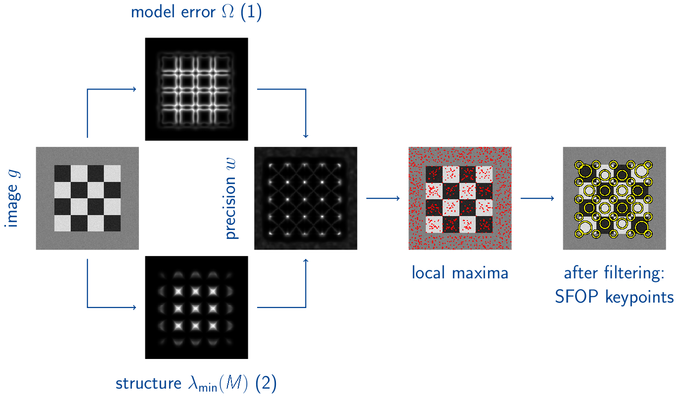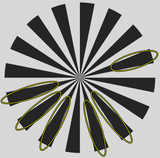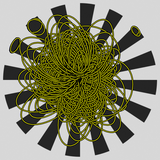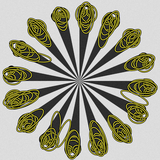Scale-invariant feature operator
Appearance
| Feature detection |
|---|
| Edge detection |
| Corner detection |
| Blob detection |
| Ridge detection |
| Hough transform |
| Structure tensor |
| Affine invariant feature detection |
| Feature description |
| Scale space |
In the fields of computer vision and image analysis, the scale-invariant feature operator (or SFOP) is an algorithm to detect local features in images. The algorithm was published by Förstner et al. in 2009.[1]
Algorithm
[edit]The scale-invariant feature operator (SFOP) is based on two theoretical concepts:
Desired properties of keypoint detectors:
- Invariance and repeatability for object recognition
- Accuracy to support camera calibration
- Interpretability: Especially corners and circles, should be part of the detected keypoints (see figure).
- As few control parameters as possible with clear semantics
- Complementarity to known detectors
scale-invariant corner/circle detector.
Theory
[edit]Maximize the weight
[edit]Maximize the weight = 1/variance of a point
comprising:
1. the image model[2]
- Distance d of an edge from a reference point p in a spiral feature
2. the smaller eigenvalue of the structure tensor
Reduce the search space
[edit]Reduce the 5-dimensional search space by
- linking the differentiation scale to the integration scale
- solving for the optimal using the model
- and determining the parameters from three angles, e. g.
- pre-selection possible:
Filter potential keypoints
[edit]- non-maxima suppression over scale, space and angle
- thresholding the isotropy :
eigenvalues characterize the shape of the keypoint, smallest eigenvalue has to be larger than threshold
derived from noise variance and significance level :
Algorithm
[edit]
Results
[edit]Interpretability of SFOP keypoints
[edit]- Results of different detectors on a Siemens star
-
Sfop: junctions red, circular features cyan
-
Edge-based Regions
-
Intensity-based Regions
See also
[edit]References
[edit]- ^ Forstner, Wolfgang; Dickscheid, Timo; Schindler, Falko (2009). "Detecting interpretable and accurate scale-invariant keypoints". 2009 IEEE 12th International Conference on Computer Vision. pp. 2256–2263. CiteSeerX 10.1.1.667.2530. doi:10.1109/ICCV.2009.5459458. ISBN 978-1-4244-4420-5.
- ^ a b Bigün, J. (1990). "A Structure Feature for Some Image Processing Applications Based on Spiral Functions". Computer Vision, Graphics, and Image Processing. 51 (2): 166–194.
- ^ Förstner, Wolfgang (1994). "A Framework for Low Level Feature Extraktion". European Conference on Computer Vision. Vol. 3. Stockholm, Sweden. pp. 383–394.







![{\displaystyle {\begin{aligned}\Omega (\mathbf {p} ,\alpha ,\tau ,\sigma )&=\sum _{n=1}^{N(\sigma )}[(\mathbf {q} _{n}-\mathbf {p} )^{T}\mathbf {R} _{\alpha }\mathbf {\nabla } _{T}g(\mathbf {q} _{n})]^{2}G_{\sigma }(\mathbf {q} _{n}-\mathbf {p} )\\&=N(\sigma )\mathbf {tr} \left\{R_{\alpha }\mathbf {\nabla } _{\tau }\mathbf {\nabla } _{\tau }^{T}R_{\alpha }^{T}*\mathbf {p} \mathbf {p} ^{T}G_{\sigma }(\mathbf {p} )\right\}\end{aligned}}}](https://wikimedia.org/api/rest_v1/media/math/render/svg/4987bd95ff37a5a63645b2c69865695be3b5a04c)


















